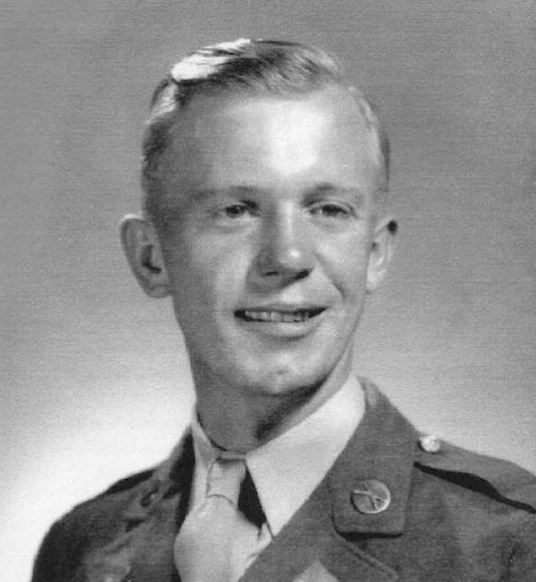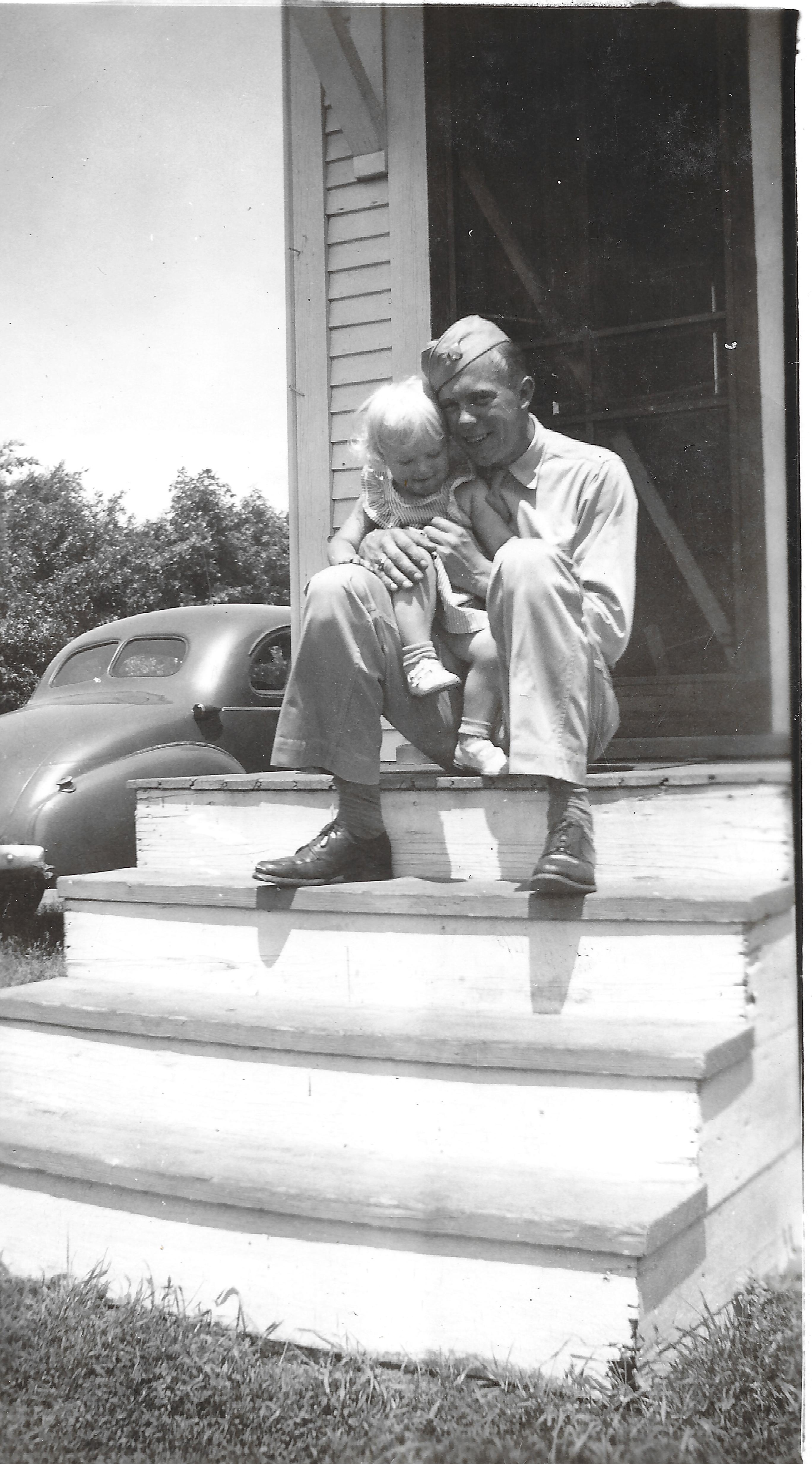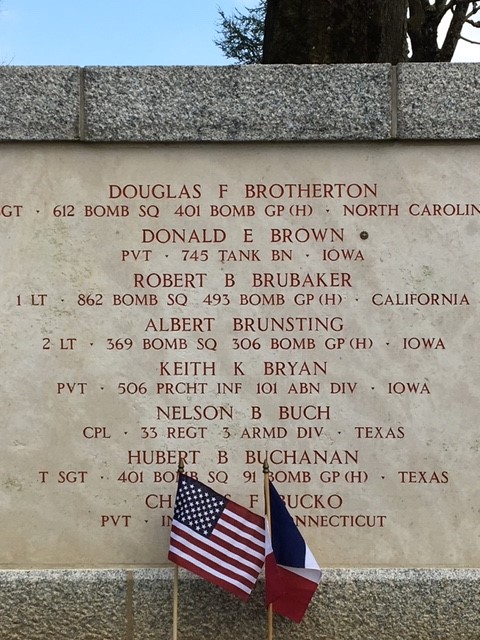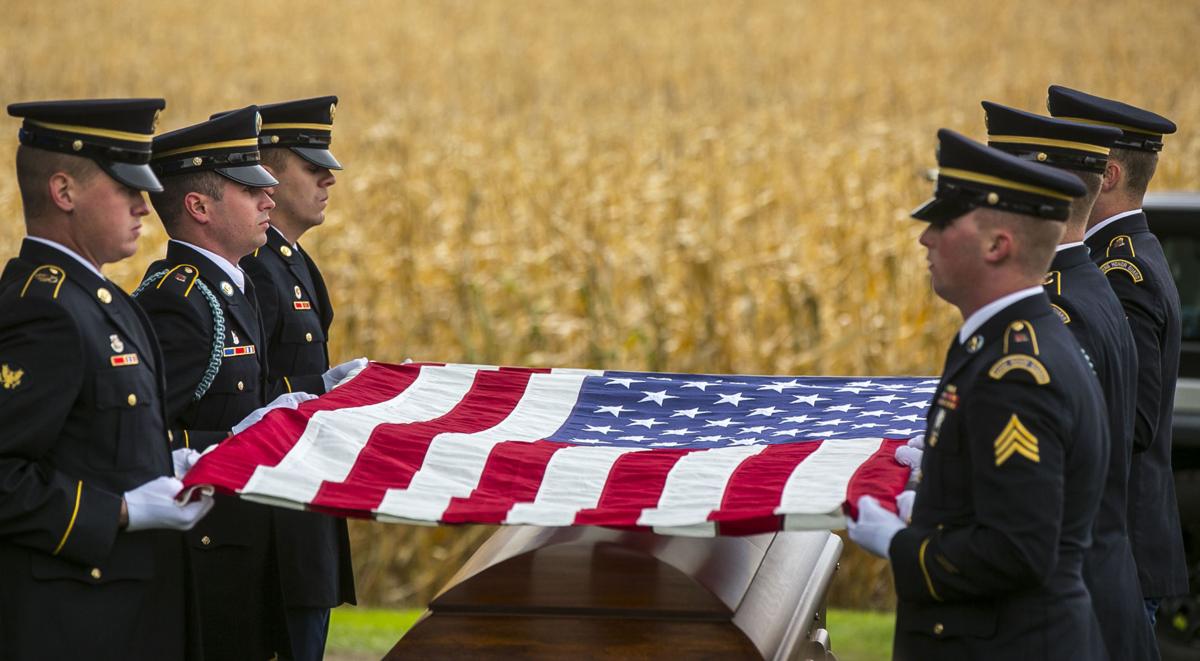Private Donald Eldon Brown

- Unit: 745th Tank Battalion, Company A
- Service Number: 37190660
- Date of Birth: January 7, 1920
- Entered the Military: March 31, 1942
- Date of Death: July 28, 1944
- Hometown: Thompson, Iowa
- Place of Death: near Monthuchon, France
- Award(s): Purple Heart
- Cemetery: Tablets of the Missing. Brittany American Cemetery, Saint-James, France
American Battle Monuments Commission
2018-2019
Early Life
On January 7, 1920, Donald Eldon Brown was born in Ventura, Iowa. He was the son of Andrew and Anna Brown. Though natives of the state, Brown and his parents had family ties to Germany and Denmark. His community was comprised of many immigrants who had ancestral ties to Denmark, Germany, Ireland, Norway, Russia, Sweden.
Brown was the youngest of the four children in the family. The Browns had three sons, Leo, Percy, and Donald, and one daughter, Lillian. Brown grew up on his parents’ farms in Iowa. Brown had a large extended family that counted as many as 17 aunts and uncles and many cousins.
Brown started school when he was five. His sister, Lillian, remembered rides to school: “we rode in a horse-drawn, green school bus. When the dirt roads were deep with ruts we sometimes had to go to school in a wagon. When there were big drifts or snow, we were picked up in a bobsled.”
When school was done, Brown and his brothers and sister helped their parents with chores or on the farm. He would sometimes have friends come over to their place. Like his mother, Brown got along well with everyone and never had problems making new friends. Growing up on a farm, he was always surrounded by animals, including goats, mules, and horses. He has a special appreciation for Beauty, a blind, black, fat pony.
One day, Brown called his mother from a neighbor’s farm, asking if he could bring a kid home with him. His mother said of course. About half an hour later, Brown returned home and hollered his mother to come outside. He was there, sitting on his pony Beauty with a little goat. This was the kid he had called her about!
Despite his family’s hard work on the farm, the Great Depression of the 1930s did not spare the Browns. In his community some farmers had their farms repossessed by the bank while others had to rent out their farmland. Andrew Brown was a good farmer, and the family worked on many farms owned by investors. The family moved frequently, living in Klemme, Hayfield, and Algona, Iowa. With all the travel, it became hard for Brown to keep up at school. He was a freshman at Hayfield High School, a sophomore at Algona High School, and a junior at Thompson High School. Instead of finishing his senior year, Brown helped his father with the farm until he joined the U.S. Army in April 1942. Several of his cousins had joined the U.S. Navy a few years prior, which had also influenced his brother, Percy, to enlist too.
Military Experience
Brown reported to Des Moines, Iowa and later trained in Camp Roberts, California and in Texas.
While in California, Brown frequently sent letters home. His mother kept him updated on life in Thompson and family happenings. He wrote to them about training and how he looked forward to being back on Iowa soil soon.
Brown received his only furlough in 1943. He went back to his parents’ farm for a few days. Much of his time was spent enjoying the farm life again and riding his father’s newly-bought tractor with his nephew. When he returned to work, he continued to keep in close contact with his family. His mother sent him letters regularly and sometimes packages that he shared with his mates.
Deployment
The U.S. Army deployed Brown’s unit overseas in March 1944, almost two years after he enlisted. He first embarked to England with the 745th Tank Battalion, Company A, attached to the 1st Armored Division. The battalion activated on August 15, 1942 at Camp Bowie, Texas.
The 745th Tank Battalion was a part of the U.S. Army’s tank corps. It left New York on August 20, 1943 and arrived in Scotland five days later. According to the unit history,
On August 26 the men disembarked to the tingling wails of bagpipes, played by a group of Highlanders resplendent in their multi-colored kilts. After this memorable welcome, a train of the London, Midland, and Scottish Railroad took the Battalion through Glasgow, Carlyle, Leeds, and Derby to its ultimate destination at Camp Ogbourne St. George, near Swindon, Wiltshire, England.
During World War II, the U.S. Army used tanks to suppress strong points: bunkers, light artillery, and other tanks. A tank battalion had about 750 men and officers assigned to the unit, and 59 Sherman tanks (the “M4 Sherman” was the most-used tank for the Americans). The battalion was divided into companies (17 tanks per company). Each company had several platoons (five tanks per platoon) and each platoon was divided into several individual tank units with a crew of five men: commander, gunner, loader, driver, and assistant driver/bow gunner.
Landing in France
Brown remained in England until the Allied invasion of France. The 745th Tank Battalion landed on Omaha Beach on June 6, 1944 at about 12:20 p.m., with the Reconnaissance Platoon in the lead. The initial assault on Omaha Beach had started at 6:30 a.m., with 96 tanks as a part of the force. The 741st Tank Battalion supported the initial beach assault of the 16th Regiment Combat Team with approximately 76 medium tanks. The 741st opted to use the concept of dual drive (DD) tanks that had the ability to “swim” ashore. Of the 32 DD tanks deployed off the coast, only five made it ashore.
Of the other standard tanks that came ashore on Landing Craft Tanks (LCTs), only ten contributed to the fight. The first tank company that came ashore for the 745th Tank Battalion was Company B; they landed about 3:00 p.m. Company C was next ashore. They debarked at 10:00 a.m. on June 7. Company A also landed in the same morning.
It is unclear whether Brown’s took part in the D-Day landings on the beaches of Normandy or joined the unit at a later date.
By June 12, the 745th Tank Battalion pushed south, hedgerow by hedgerow in support of the 1st Infantry Division, establishing a line along the highway between Le Vacquerie and Caumont, which was the farthest inland penetration of the Allied front.
At 11:00 p.m. on July 20, Company A crossed their starting point near Vouilly to get into the rally point for Operation Cobra. Movements to get to rally point were critical and could be dangerous. They were conducted at night so that they could not be observed by the enemy and it would give them time to build a counter-defense. Company A practiced working with the infantrymen for the 1st Infantry Division, 16th Infantry Regiment who were to ride on top of the tanks into battle. Due to the proximity to the frontline, camouflaging remained necessary: the individual pup tents had to either be taken down or camouflaged. July 25 was D-Day for Operation Cobra.
Operation Cobra
On July 26, the 1st Infantry Division and the 745th Tank Battalion started their advance to the battle. Progress was slow and the group faced only light enemy resistance. On July 28, 1944, Brown’s unit moved towards Monthuchon, France.
All of the units suffered under heavy artillery and mortar fire from Germany’s 2nd Panzer Division. Eventually, two of the enemy tanks were destroyed in the battle. In addition to the four of its tanks that were taken down, two U.S. officers and six enlisted men were wounded, and three enlisted men were killed.
Although the 745th Tank Battalion’s after-action report did not mention the names of the enlisted men, it is believed that Private Donald E. Brown was among those killed in action.
On August 28, 1944, the War Department sent a letter to Mr. and Mrs. Andrew J. Brown informing them that their son was killed in action on July 28.

Eulogy
By the end of World War II, several hundred temporary burial grounds had been established by the U.S. Army on the battlefield. In 1947, several sites overseas were selected to become permanent cemeteries by the Secretary of the Army and the American Battle Monuments Commission. In addition to grave sites, these cemeteries also commemorate by name U.S. service members who were missing in action, or lost or buried at sea during the war.
Donald E. Brown’s name was inscribed on the Wall of the Missing at Brittany American Cemetery, in Saint-James, France, along with the names of 499 other service members declared Missing in Action.
In July 1947, an investigation by the American Graves Registration Command (AGRC) discovered a Private Brown’s dog tags by a set of remains. However, the nature of the remains made it impossible to accurately identify the soldier as Brown. The AGRC shipped the remains and the dog tags to the Central Identification Point (CIP) in Blosville, France. Brown’s remains were eventually declared to be non-recoverable by the Quartermaster General Office. On October 5, 1949, they were interred in plot A, row 2, grave 17 at St. Laurent cemetery, known today as Normandy American Cemetery, in Colleville-sur-Mer, France.
In August 2017, after receiving requests from the family and extensive research started in 2012, the Defense POW/MIA Accounting Agency (DPAA) opened a case that led to the exhumation of X-452’s remains. In June 2018, after months of investigation, the DPAA finally identified the remains of Private Donald E. Brown. Of all the more than 72,000 service members who are still unaccounted for from World War II, approximately 26,000 are considered to be “possibly-recoverable.”
After being buried for several decades at Normandy American Cemetery under an anonymous headstone that read, “Here rests in honored glory an American comrade known but to God,” Brown’s family requested that his remains be repatriated to the United States for permanent burial in his hometown. On October 6, 2018, a ceremony was held at Rose Hill Cemetery in Thompson, Iowa. Members of the Iowa National Guard laid 24-year-old Donald Eldon Brown’s remains to rest. A bronze rosette was added to his name at Brittany American Cemetery.


Reflection
Bibliography
1st Infantry Division; World War II Operations Reports, Records of the Adjutant General’s Office, Record Group 407 (Boxes 5248-5249); National Archives at College Park, College Park, MD.
Armored Battalion; World War II Operations Reports, Records of the Adjutant General’s Office, 1917-, Record Group 407 (Boxes 13509-13510); National Archives at College Park, College Park, MD.
Defense POW/MIA Accounting Agency. Memorandum for the Record – Family Request to Compare Unknown X-425 Blosville with one Unresolved World War II Casualty. March 28, 2017.
Donald E. Brown, Individual Deceased Personnel File, Department of the Army.
Donald E. Brown, VA Master Index Card and Hospital Report, Department of the Army. National Archives and Records Administration – St. Louis.
Donald E. Brown: A Life Cut Short. Courtesy of Lillian Brown and Joyce Sorensen.
Donald E. Brown Official Military Personnel File. Military Personnel Records Center, National Archives and Records Administration, St. Louis.
“Funeral Announcement For Soldier Killed During World War II (Brown, D.)”. Defense POW/MIA Accounting Agency. Updated September 28, 2018. Accessed September 11, 2019. www.dpaa.mil/News-Stories/News-Releases/PressReleaseArticleView/Article/1647847/funeral-announcement-for-soldier-killed-during-world-war-ii-brown-d/.
Howenstine, Harold. History of the 745th Tank Battalion, August 1942 to June 1945. Nuremberg, Germany, 1945.
Iowa. Cerro Gordo County 1900 U.S. Federal Census. Digital Images. ancestry.com.
Iowa. Hancock County. 1920 U.S. Federal Census. Digital Images. ancestry.com.
Iowa. Liberty County. 1930 U.S. Federal Census. Digital Images. ancestry.com.
Iowa. Winnebago County. 1940 U.S. Federal Census. Digital Images. ancestry.com.
Omaha Beachhead (6 June – 13 June 1944). Washington, D.C.: Government Printing Office, 1994. history.army.mil/html/books/100/100-11/CMH_Pub_100-11_plus-maps.pdf.
Stanton, Shelby. World War II Order of Battle, An Encyclopedic Reference to U.S. Army Ground Forces from Battalion through Division 1939-1946. Mechanicsburg: Stackpole Books, 2006.
Zaloga, Steven. Operation Cobra 1944 – Breakout from Normandy. Oxford: Osprey Publishing Ltd, 2001.
This profile was researched and created with the Understanding Sacrifice program, sponsored by the American Battle Monuments Commission.

